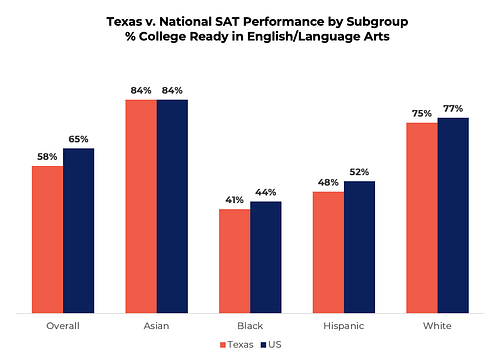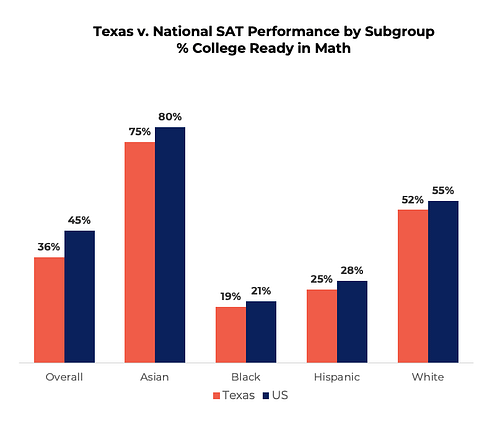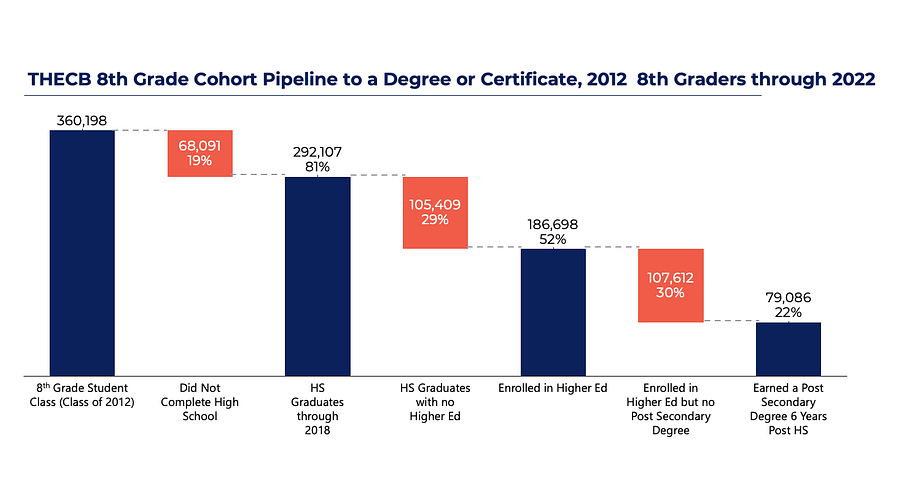Student readiness: Texas parents are worried
Texas 2036 and the George W. Bush Institute explore student career readiness and its impacts on Texas’ future prosperity in their report “The State of Readiness: Are Texas students prepared for life after high school?” Here is a preview of what the data says about Texas students and their worried parents (find parts I, II and III below).
What data tells us about the readiness of Texas students
 A lack of readiness can have life-long consequences for students. As they explore career pathways, students take specific exams – the SAT, the ACT, and the Texas Success Initiative (TSI) exam – that help inform what post-secondary options they pursue.
A lack of readiness can have life-long consequences for students. As they explore career pathways, students take specific exams – the SAT, the ACT, and the Texas Success Initiative (TSI) exam – that help inform what post-secondary options they pursue.
Because the students taking these tests perceive themselves as college-bound, the results tell an important readiness story – and a concerning one.
- The percentage of Texas students that were college ready according to their SAT or ACT score fell five percentage points, from 28% in 2018 to 23%, in 2022.
- The percentage of Texas students who were college ready on the TSI – a test students commonly take to qualify for dual credit coursework and technical college course placement – fell seven percentage points, from 38% in 2018 to 31%, in 2021.
 These results are especially concerning when Texas students are compared to their national peers on the SAT.
These results are especially concerning when Texas students are compared to their national peers on the SAT.
- Texas students consistently underperform the national average, including when looking at subgroup performance.
- In math, Texas underperforms the national average in every subgroup.
- In English and language arts, the percentage of Texas students who meet benchmarks is below the national average in every subgroup but one (Asian Americans in Texas perform at the same level as their national peers on the SAT English section, 84%).
Too many Texas students are not graduating
While Texas often boasts about its 90% graduation rate, a closer look at the progress of eighth-grade cohorts through high school and beyond reveals concerning trends.
- 19% of Texas eighth-graders do not graduate from a Texas public high school.
- 48% do not enroll in higher education.
- 78% do not receive a post-secondary degree or credential within six years of high school graduation.
Underneath these dismal topline numbers lurk deep disparities for economically disadvantaged students – a category applicable to the majority of Texas students (60.2%).
- 23% of economically disadvantaged Texas eighth-graders do not graduate from a Texas public high school.
- 57% do not enroll in higher education.
- 86% do not receive a post-secondary degree or credential within six years of high school graduation.
Texas is struggling to get students through high school. Tens of thousands of eighth-graders are regularly lost from the system. Even among those eighth-graders who do make it through high school and are working toward post-secondary education, 30% do not complete a degree or certification.
Failing to complete high school leaves too many young Texans facing an uncertain and risky economic reality – unprepared to attain a post-secondary degree or credential and cut off from good-paying jobs as a result.
A high school diploma is not sufficient
Even for those students who do graduate, a high school diploma is no longer sufficient to access a good-paying job.
In 2011, 51% of all jobs in Texas that paid $65,000 or more were held by Texans with a high school diploma, GED, or below. But by 2019, that number had dropped to just 11%. In 2019, only 11% of high-paying jobs were held by Texans with a high school diploma, GED, or below.
A high school diploma, by itself, is no longer the path to a prosperous future that it may have been for previous generations. As the Texas economy changes, the state needs to sharpen its focus on increasing student readiness for life after high school. Doing so requires more than a high school diploma.
Texas parents are worried
In a 2022 Texas 2036 survey of Texas parents, 65% of Texas parents said they are worried about whether their student is prepared for life after high school, with traditionally underserved demographics indicating much higher rates of concern. 86% of Texas families who speak Spanish at home are worried about their children not being prepared. 70% of special education and low-income families say they are concerned as well.

